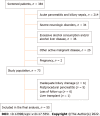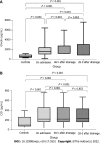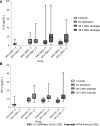Gut peptide changes in patients with obstructive jaundice undergoing biliary drainage: A prospective case control study
- PMID: 35979104
- PMCID: PMC9258356
- DOI: 10.12998/wjcc.v10.i17.5551
Gut peptide changes in patients with obstructive jaundice undergoing biliary drainage: A prospective case control study
Abstract
Background: Biliary obstruction is a relatively common condition that affects approximately 5 in 1000 people annually. Malnutrition is very common in patients with biliary obstruction and since it is associated with significant morbidity and mortality, it is important to identify factors and mechanisms involved in its development.
Aim: To determine the influence of obstructive jaundice on the hormones controlling appetite and nutritive status.
Methods: This was a prospective case control study performed in a tertiary center in Zagreb, Croatia. Patients with biliary obstruction undergoing internal biliary drainage from September 2012 until August 2013 were enrolled. After excluding patients who developed procedure related complications or were lost in the follow-up, out of initial 73 patients, 55 patients were included in the analysis, including 34 with benign and 21 with malignant disease. Meanwhile, 40 non-jaundiced controls were also included. Appetite, nutritional status, and serum ghrelin, cholecystokinin (CCK), interleukin 6 (IL-6), and tumor necrosis factor α (TNF-α) were determined at admission, 48 h and 28 d after internal biliary drainage. Chi square test was used for categorical variables. Continuous variables were analysed for normality by Kolmogorov-Smirnov test and relevant non-parametric (Mann-Whitney, Kruskal-Wallis, and Friedman) or parametric (t-test and analysis of variance) tests were used.
Results: Patients with obstructive jaundice were significantly malnourished compared to controls, regardless of disease etiology. Plasma ghrelin and CCK levels were significantly higher in patients with obstructive jaundice. Serum bilirubin concentrations were negatively correlated with ghrelin levels and positively correlated with TNF-α, but had no correlation with CCK concentrations. After internal biliary drainage, a significant improvement of nutritional status was observed although serum concentrations of ghrelin, IL-6, and TNF-α remained significantly elevated even 28 d after the procedure. CCK levels in patients without malnutrition remained elevated 28 d after the procedure, but in patients with malnutrition, CCK levels decreased to levels comparable with those in the control group. We have not established any correlation between appetite and serum levels of ghrelin, CCK, IL-6, and TNF-α before and after biliary drainage.
Conclusion: Possible abnormalities in ghrelin and CCK regulation may be associated with the development of malnutrition during the inflammatory response in patients with biliary obstruction.
Keywords: Biliary obstruction; Cholecystokinin; Ghrelin; Malnutrition.
©The Author(s) 2022. Published by Baishideng Publishing Group Inc. All rights reserved.
Conflict of interest statement
Conflict-of-interest statement: The authors declare that there is no conflict of interest to disclose.
Figures



Similar articles
-
Factors predicting nutritional derangements in patients with obstructive jaundice: multivariate analysis.World J Surg. 2001 Apr;25(4):413-8. doi: 10.1007/s002680020043. World J Surg. 2001. PMID: 11344390
-
Anorexia and the effect of internal biliary drainage on food intake in patients with obstructive jaundice.J Am Coll Surg. 2001 May;192(5):584-90. doi: 10.1016/s1072-7515(01)00841-9. J Am Coll Surg. 2001. PMID: 11333095
-
Changes in the pattern of visceral protein concentrations after internal biliary drainage in patients with obstructive jaundice.Eur J Surg. 1999 Jun;165(6):550-5. doi: 10.1080/110241599750006442. Eur J Surg. 1999. PMID: 10433138
-
Pathophysiological consequences of obstructive jaundice and perioperative management.Hepatobiliary Pancreat Dis Int. 2018 Feb;17(1):17-21. doi: 10.1016/j.hbpd.2018.01.008. Epub 2018 Jan 31. Hepatobiliary Pancreat Dis Int. 2018. PMID: 29428098 Review.
-
Current status of preoperative drainage for distal biliary obstruction.World J Hepatol. 2015 Aug 28;7(18):2171-6. doi: 10.4254/wjh.v7.i18.2171. World J Hepatol. 2015. PMID: 26328029 Free PMC article. Review.
Cited by
-
Skeletal muscle status and survival among patients with advanced biliary tract cancer.Int J Clin Oncol. 2024 Mar;29(3):297-308. doi: 10.1007/s10147-023-02466-z. Epub 2024 Feb 6. Int J Clin Oncol. 2024. PMID: 38319509 Free PMC article.
References
-
- Pavlidis ET, Pavlidis TE. Pathophysiological consequences of obstructive jaundice and perioperative management. Hepatobiliary Pancreat Dis Int. 2018;17:17–21. - PubMed
-
- Padillo FJ, Andicoberry B, Muntane J, Lozano JM, Miño G, Sitges-Serra A, Pera-Madrazo C. Factors predicting nutritional derangements in patients with obstructive jaundice: multivariate analysis. World J Surg. 2001;25:413–418. - PubMed
-
- Padillo FJ, Andicoberry B, Pera-Madrazo C, Sitges-Serra A. Anorexia and malnutrition in patients with obstructive jaundice. Nutrition. 2002;18:987–990. - PubMed
LinkOut - more resources
Full Text Sources

